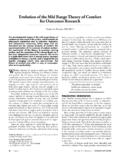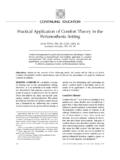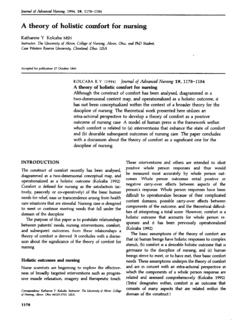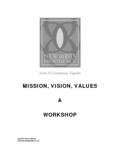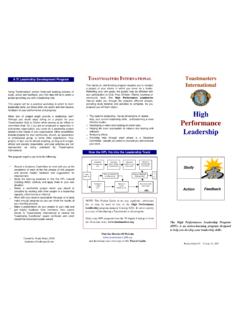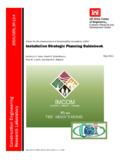Transcription of Comfort Theory - The Comfort Line
1 JONA. Volume 36, Number 11, pp 538-544. B2006, Lippincott Williams & Wilkins, Inc. THE JOURNAL OF NURSING ADMINISTRATION. Comfort Theory A Unifying Framework to Enhance the Practice Environment Katharine Kolcaba, PhD, RN,C. Colette Tilton, MS, ARNP, CNAA, BC. Carol Drouin, MS, ARNP, BC. The application of Theory to practice is multi- This sense of empowerment and the challenge of faceted. It requires a nursing Theory that is compati- Magnet status led to our decision to find one Theory ble with an institution's values and mission and that fit our values and mission. Such a Theory could that is easily understood and simple enough to provide real direction in further enhancing our work guide practice. Comfort Theory was chosen because environment, an all-important aspect in achieving of its universality. The authors describe how Magnet status.
2 Kolcaba's Comfort Theory was used by a not-for- profit New England hospital to provide a coherent and consistent pattern for enhancing care and Selecting a Theory promoting professional practice, as well as to serve The decision to explore the adoption of a single as a unifying framework for applying for Magnet nursing Theory was initiated by staff nurses. After Recognition Status. taking a graduate nursing Theory course, 3 members of our staff suggested that the right'' Theory would The working milieu at our hospital had matured to enhance practice by providing a consistent and the point where the staff nurses and administrators thematic focus instead of our institution's current felt ready to undergo the journey to achieve Magnet philosophy of care based on an eclectic array of status. While analyzing what needed to be done to concepts borrowed from several nursing theorists.
3 Accomplish this daunting goal, the task force The 3 students, together with our chief nursing realized that our existing Theory base was eclectic, officer (CNO), met and discussed Theory require- not well defined or understood, and not practical ments and how to choose one overarching Theory for everyday use. Therefore, we were essentially that fits our practice culture. We decided that a good practicing and conducting research in a piece meal, first step would be to invite a nursing Theory atheoretical, and inconsistent manner. We had no professor from a nearby college to acquaint clinical cohesive vision or framework that would serve as a nurses with key theoretical concepts and their guide in developing and achieving leadership, prac- application. Nursing staff were invited to attend an tice, or research goals.
4 Open forum on how theories can guide practice. Our nurses nonetheless felt empowered by our This sparked a renewed interest in the application of mutual decision to work toward Magnet status. nursing theories within the nursing department. After several theories were researched, we decided that 2 theories met our criteria. Kolcaba's Authors' affiliations: Associate Professor (Dr Kolcaba), The Comfort Theory1 and Jean Watson's Theory of University of Akron College of Nursing, Akron, Ohio; Vice President, Patient Care Services (Ms Tilton); Clinical Staff (Ms Caring2 were discussed by the nursing staff at Drouin), Southern New Hampshire Medical Center, Nashua multiple sessions. The staff selected Comfort Theory NH. (CT) by Kolcaba because it most represented our Corresponding author: Dr Kolcaba, The University of Akron College of Nursing, Mary Gladwin Hall, Akron, OH 44325- philosophy of care and values and its effects were 3701 easier to measure.
5 Having the staff participate 538 JONA Vol. 36, No. 11 November 2006. Copyr ight Lippincott Williams & Wilkins. Unauthorized reproduction of this article is prohibited. actively at this early stage engaged them in the The Campaign selection and implementation processes. Dr Kolcaba was invited to New England for In preparation for Kolcaba's visit, there was an in- a 2-day interactive consultation with staff nurses, tensive campaign to promote CT. The campaign un- nursing leaders, and the CNO. Kolcaba was asked folded in 3 stages: increasing name recognition of to focus on both the Comfort of nurses, an the Theory and its author, introducing all staff to the application of the Theory not as familiar to the staff, basic elements of the Theory , and presenting clinical and the Comfort of patients and families. Nurses as examples of CT.
6 The following actions were taken: care givers often ignore their own Comfort in lieu of (a) disseminating the book Comfort Theory and the Comfort of patients and families. Kolcaba Practice1 to all units in the hospital; (b) using a believed that the Comfort of nurses is an important color theme for all communications that matched factor in morale and ultimately impacts recruitment the cover of the book; (c) creating bookmarks with and retention. the date of the workshop and brief excepts from the book; (d) distributing business-sized cards with a Background of CT reminder of the workshop dates; (e) designing pins Initially, CT was developed as a patient/family- for staff that stated, Ask me about Comfort ''; (f) in- centered Theory . Kolcaba's initial analysis of the viting faculty from area nursing schools and nursing concept of comfort3 revealed the strengthening leadership to attend a reception with the author; (g).
7 Aspect of Comfort as being central to nursing. She conducting an informal survey of various personnel defined 3 types of Comfort : (a) reliefVthe state of (healthcare and ancillary), asking how they brought having a specific Comfort needs met; (b) easeVthe Comfort to patients and families; and (h) displaying state of calm or contentment; and (c) transcendenceV each person's name, picture, and their comments the state in which one can rise above problems or from the survey on large color-coordinated posters. ,2 Wilson and Kolcaba4 observed that dis- The campaign spanned several months and reached Comfort is more than a negative physical sensation all levels of the healthcare organization. or emotional distress and that other aspects of Comfort /discomfort affect holistic beings. There- Consultative Visit fore, CT was congruent with nursing values and domains such as care, symptom management, At 2 identical sessions organized around breakfast interaction, holism, healing environment, identifi- and lunch, Kolcaba presented the clinical staff a cation of needs, and homeostasis.
8 Brief overview of CT that focused on 2 major In addition, human experience takes place in 4 themes: (a) enhancing the Comfort of nurses through contexts: physical, psychospiritual, sociocultural, environmental changes, which would encourage and ,5 Physical Comfort is defined nurses and other valued employees to remain with as all physiological and homeostatic dimensions of the institution and participate in the entire culture, an individual; psychospiritual Comfort is defined as and (b) enhancing the Comfort of patients and their an internal awareness of self, including esteem, families during hospital stays. Both of these themes identity, sexuality, meaning in one's life, and one's served to enhance the practice environment. understood relationship with a higher being; so- ciocultural Comfort is defined as interpersonal, Enhancing the Comfort of Nurses family, and societal relationships (finances, teaching, Comfort Theory proposes that when the Comfort of healthcare personnel, family traditions, rituals, and nurses is enhanced, nurses are more satisfied, more religious practices); and environmental Comfort is committed to the institution, and able to work more defined as the external background of human expe- effectively.
9 These nurse outcomes result in improved rience (temperature, light, sound, odor, color, furni- patient outcomes and increased organizational ture, landscape, etc). Comfort Theory proposes An extensive literature review by Kolcaba that, when patients and their families are more about what nurses want in their workplaces comfortable, they engage more fully in health- revealed many factors that could be organized seeking behaviors that include internal behaviors, according to the contexts of Comfort as explicated external behaviors, or a peaceful death. When pa- in CT (physical, psychospiritual, sociocultural, and tients and families engage in health-seeking behav- environmental [organizational structure]). The com- iors more fully, the institution benefits in such areas fort factors from the review generated a great deal as reduced cost of care and length of stay, increased of interest from our audience of nurses.
10 A list of patient satisfaction, enhanced financial stability, these factors, under each context, is in Figure 1. For more positive publicity, and so ,6 these presentations, comfortable environment'' was JONA Vol. 36, No. 11 November 2006 539. Copyr ight Lippincott Williams & Wilkins. Unauthorized reproduction of this article is prohibited. Figure 1. Comfort of Nurses*. Physical Comfort Clean, safe environment; attractive, convenient, and clean lounge; restful breaks; good coffee, tea, etc; flexible scheduling;. off duty on time; no rotating shifts; continuity of patient care; adequate staffing; resources allocated consistently and fairly;. control over resources; equipment that works, is available, and is complete; good salary, benefits, profit sharing, and retirement; increased routinization; day care available; noise controlled; pleasant and efficient physical layout; enough room to work; self-scheduling.
